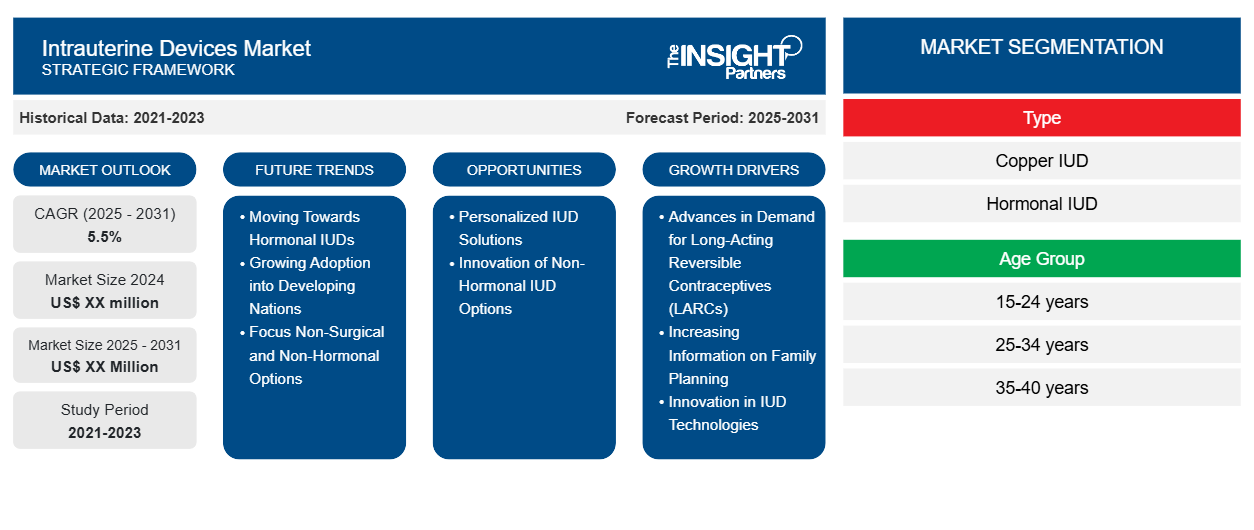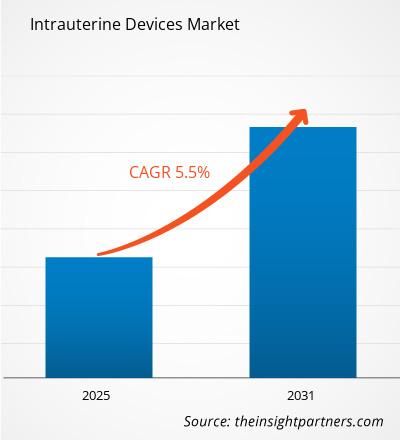The Intrauterine Devices Market is expected to register a CAGR of 5.5% from 2025 to 2031, with a market size expanding from US$ XX million in 2024 to US$ XX Million by 2031.
The report presents an analysis based on Type (Copper IUD, Hormonal IUD), Age Group (15-24 years, 25-34 years, 35-40 years, and Above 40 years), End User (Hospitals, Specialty Clinics, and Others). The global analysis is further broken-down at regional level and major countries. The market size and forecast at global, regional, and country levels for all the key market segments are covered under the scope. The report offers the value in USD for the above analysis and segments. The report provides key statistics on the market status of the key market players and offers market trends and opportunities.
Purpose of the Report
The report Intrauterine Devices Market by The Insight Partners aims to describe the present landscape and future growth, top driving factors, challenges, and opportunities. This will provide insights to various business stakeholders, such as:
- Technology Providers/Manufacturers: To understand the evolving market dynamics and know the potential growth opportunities, enabling them to make informed strategic decisions.
- Investors: To conduct a comprehensive trend analysis regarding the market growth rate, market financial projections, and opportunities that exist across the value chain.
- Regulatory bodies: To regulate policies and police activities in the market with the aim of minimizing abuse, preserving investor trust and confidence, and upholding the integrity and stability of the market.
Intrauterine Devices Market Segmentation
Type
- Copper IUD
- Hormonal IUD
Age Group
- 15-24 years
- 25-34 years
- 35-40 years
- Above 40 years
End User
- Hospitals
- Specialty Clinics
- Others
Geography
- North America
- Europe
- Asia-Pacific
- South and Central America
- Middle East and Africa
You will get customization on any report - free of charge - including parts of this report, or country-level analysis, Excel Data pack, as well as avail great offers and discounts for start-ups & universities
Intrauterine Devices Market: Strategic Insights

-
Get Top Key Market Trends of this report.This FREE sample will include data analysis, ranging from market trends to estimates and forecasts.
Intrauterine Devices Market Growth Drivers
- Advances in Demand for Long-Acting Reversible Contraceptives (LARCs): The major factor propelling the IUD market is the growing long-acting reversible contraception adoption. Today, women have moved from seeking an effective 'set-and-forget' birth control method to being most attracted to the reliable IUD, since it dispenses with daily monitoring. Thus, the trend for globally permanent but reversible methods of contraceptives is growing.
- Increasing Information on Family Planning: Improved awareness of family planning devices is causing rising interest in the demand and use of IUDs. Campaigns of public awareness and education as well as better access to reproductive health have made women choose IUDs as a safe and secure contraceptive method. In this context, as part of the international movement for reproductive rights, Sacha cities are driving the demand for more IUDs across developing and developing geographies.
- Innovation in IUD Technologies: Innovation in IUD Technology is the Propellant that Drives the Mile. Most importantly, modern IUDs are less discomforting and easier to insert compared to the early IUDs. The result of other innovations such as hormone-releasing IUDs, which have other added benefits such as decreased menstrual bleeding, become attractive to more women and conserves that growing number of users of intrauterine devices
Intrauterine Devices Market Future Trends
- Moving Towards Hormonal IUDs: Hormonal IUDs increasingly outweigh copper IUDs for preference in the market and are gradually catching on as well. This form of intrauterine device comes along with extra benefits which include lighter periods and less severe menstrual cramps thus attracting users. Consequently, this trend is altering market dynamics with demand by women for contraception that doubles as a benefit to hormonal health on the rise.
- Growing Adoption into Developing Nations: The intrauterine devices market is finding more and more excellent acceptance in developing countries. Increasing access of reproductive health care and growing awareness towards various contraceptive methods are factors that have received many developing nations such as those in Asia and Africa as suitably good for IUD-related growth. Family planning initiatives launched by the government and a myriad of NGO efforts are also contributing to the growth of this market for those up taking IUDs,
- Focus Non-Surgical and Non-Hormonal Options: An upsurge evident toward the noninvasive as well as hormonal-free intrauterine device approaches, like copper IUDs. They are women wanting a nearly natural birth control method. The devices as long-term contraceptives are available without using hormones and well suited for people preferring hormone-free solutions. It is allowing the market to move toward women seeking a method that's really noninvasive and nonhormonal.
Intrauterine Devices Market Opportunities
- Personalized IUD Solutions: There is a huge opening in the financing of personal needs with regard to intrauterine devices. The personal tails of these IUDs will go a long way in covering the aforementioned area of specialization, whether in size, material preferences, or hormonal content, and thus include a larger number of women. Therefore, there would be more choices, which would encourage comfort, effectiveness, and satisfaction, resulting to increased adoption by different consumer groups.
- Innovation of Non-Hormonal IUD Options: There is an emerging opportunity for innovation and commercialization in advanced copper IUDs and other non-hormonal contraceptive options, as an increasing number of women adopts ways of preventing conception not based on hormones. Hence, with the growing desire for non-hormonal contraception, the door will be open for manufacturers to enjoy a wider market in this developing need for long-term, non-intrusive methods of birth control.
Intrauterine Devices Market Regional Insights
The regional trends and factors influencing the Intrauterine Devices Market throughout the forecast period have been thoroughly explained by the analysts at The Insight Partners. This section also discusses Intrauterine Devices Market segments and geography across North America, Europe, Asia Pacific, Middle East and Africa, and South and Central America.
Intrauterine Devices Market Report Scope
| Report Attribute | Details |
|---|---|
| Market size in 2024 | US$ XX million |
| Market Size by 2031 | US$ XX Million |
| Global CAGR (2025 - 2031) | 5.5% |
| Historical Data | 2021-2023 |
| Forecast period | 2025-2031 |
| Segments Covered |
By Type
|
| Regions and Countries Covered |
North America
|
| Market leaders and key company profiles |
|
Intrauterine Devices Market Players Density: Understanding Its Impact on Business Dynamics
The Intrauterine Devices Market is growing rapidly, driven by increasing end-user demand due to factors such as evolving consumer preferences, technological advancements, and greater awareness of the product's benefits. As demand rises, businesses are expanding their offerings, innovating to meet consumer needs, and capitalizing on emerging trends, which further fuels market growth.

- Get the Intrauterine Devices Market top key players overview
Key Selling Points
- Comprehensive Coverage: The report comprehensively covers the analysis of products, services, types, and end users of the Intrauterine Devices Market, providing a holistic landscape.
- Expert Analysis: The report is compiled based on the in-depth understanding of industry experts and analysts.
- Up-to-date Information: The report assures business relevance due to its coverage of recent information and data trends.
- Customization Options: This report can be customized to cater to specific client requirements and suit the business strategies aptly.
The research report on the Intrauterine Devices Market can, therefore, help spearhead the trail of decoding and understanding the industry scenario and growth prospects. Although there can be a few valid concerns, the overall benefits of this report tend to outweigh the disadvantages.
Frequently Asked Questions
Who are the prominent players in Intrauterine Devices Market ?
What is one of the main future trends of the Intrauterine Devices Market ?
Which region dominated the Intrauterine Devices Market in 2023?
What is the expected CAGR of the Intrauterine Devices Market?
What are the driving factors impacting the Intrauterine Devices Market ?
Which is the fastest growing region in Intrauterine Devices Market ?
- Historical Analysis (2 Years), Base Year, Forecast (7 Years) with CAGR
- PEST and SWOT Analysis
- Market Size Value / Volume - Global, Regional, Country
- Industry and Competitive Landscape
- Excel Dataset
Recent Reports
Testimonials
Reason to Buy
- Informed Decision-Making
- Understanding Market Dynamics
- Competitive Analysis
- Identifying Emerging Markets
- Customer Insights
- Market Forecasts
- Risk Mitigation
- Boosting Operational Efficiency
- Strategic Planning
- Investment Justification
- Tracking Industry Innovations
- Aligning with Regulatory Trends





















 Get Free Sample For
Get Free Sample For